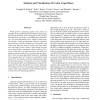281 search results - page 47 / 57 » Code Compaction Using Genetic Algorithms |
BMCBI
2002
13 years 6 months ago
2002
Background: Biologists are often interested in performing a simple database search to identify proteins or genes that contain a well-defined sequence pattern. Many databases do no...
BIBE
2006
IEEE
14 years 24 days ago
2006
IEEE
While genomic sequencing projects have proved an abundant source of information for biological studies ranging from the molecular to the ecological in scale, much of the informati...
CEC
2005
IEEE
14 years 10 days ago
2005
IEEE
The building blocks are common structures of high-quality solutions. Genetic algorithms often assume the building-block hypothesis. It is hypothesized that the high-quality solutio...
EUSFLAT
2009
13 years 4 months ago
2009
One of the new trends in genetic fuzzy systems (GFS) is the use of evolutionary multiobjective optimization (EMO) algorithms. This is because EMO algorithms can easily handle two c...
KDD
2003
ACM
14 years 7 months ago
2003
ACM
Two-dimensional contingency or co-occurrence tables arise frequently in important applications such as text, web-log and market-basket data analysis. A basic problem in contingenc...


